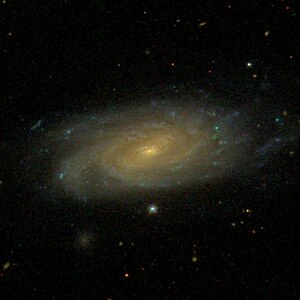NGC 1090
| Galaxy NGC 1090 |
|
|---|---|

|
|
| SDSS recording | |
| AladinLite | |
| Constellation | whale |
|
Position equinox : J2000.0 , epoch : J2000.0 |
|
| Right ascension | 02 h 46 m 33.9 s |
| declination | -00 ° 14 ′ 50 ″ |
| Appearance | |
| Morphological type | SB (rs) bc |
| Brightness (visual) | 11.8 mag |
| Brightness (B-band) | 12.6 mag |
| Angular expansion | 3.9 ′ × 1.8 ′ |
| Position angle | 102 ° |
| Surface brightness | 13.8 mag / arcmin² |
| Physical data | |
| Redshift | 0.009206 ± 0.000013 |
| Radial velocity | 2760 ± 4 km / s |
|
Stroke distance v rad / H 0 |
(124 ± 9) · 10 6 ly (37.9 ± 2.7) Mpc |
| history | |
| discovery | William Herschel |
| Discovery date | October 9, 1785 |
| Catalog names | |
| NGC 1090 • UGC 2247 • PGC 10507 • CGCG 389-011 • MCG + 00-08-011 • IRAS 02440-0027 • 2MASX J02463391-0014493 • GC 606 • H II 465 • h 266 • HIPASS J0246-00b | |
NGC 1090 is a barred spiral galaxy of the Hubble type SBbc in the constellation Whale south of the ecliptic . It is estimated to be 124 million light-years away from the Milky Way and has a diameter of around 145,000 ly.
In the same area of the sky are the galaxies NGC 1087 , NGC 1094 , NGC 1104 , IC 264 .
The supernovae SN 1962K and SN 1971T were observed here.
The object was discovered by Wilhelm Herschel on October 9, 1785 .
Web links
Commons : NGC 1090 - collection of images, videos, and audio files
